Client-Nurse Relationship: Maintaining Therapeutic Bonds in Healthcare
VerifiedAdded on 2021/04/21
|5
|1014
|68
Essay
AI Summary
This essay examines the critical role of the client-nurse relationship in healthcare, emphasizing the development of therapeutic bonds and culturally competent care. The author, a nursing professional, highlights the advantages of such relationships, including improved patient outcomes and satisfaction. The case of an aboriginal woman, Mrs. Brenga, illustrates the importance of trust, respect, and empathy in overcoming cultural barriers and fostering collaboration. The essay discusses five key traits – trust, respect, professional intimacy, empathy, and proper utilization of power – that contribute to effective client-nurse interactions. The author stresses the significance of ethical and legal frameworks, as well as the nurse's ability to advocate for clients, leading to high-quality care and enhanced patient well-being. References to supporting literature are included to validate the points made.
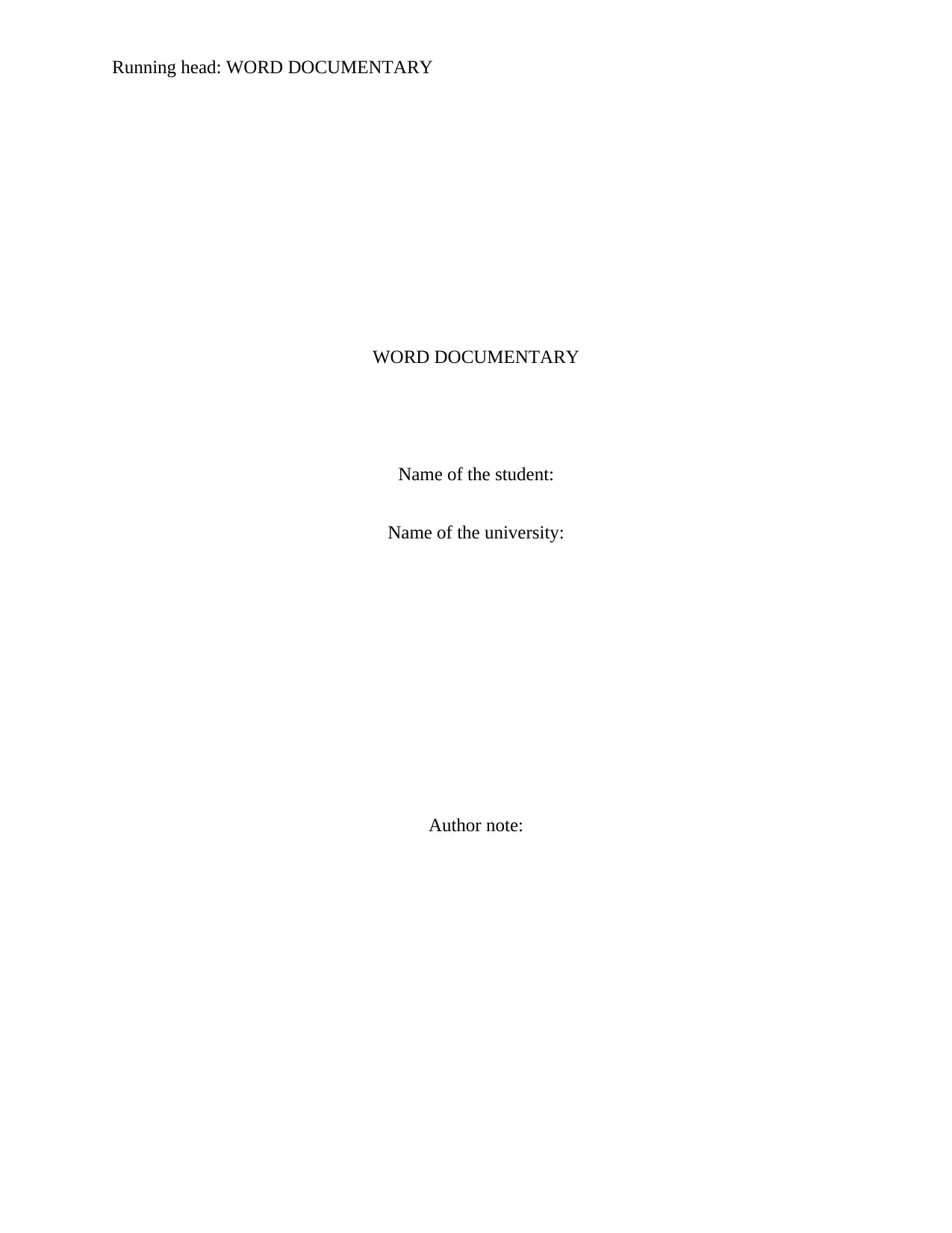
Running head: WORD DOCUMENTARY
WORD DOCUMENTARY
Name of the student:
Name of the university:
Author note:
WORD DOCUMENTARY
Name of the student:
Name of the university:
Author note:
Paraphrase This Document
Need a fresh take? Get an instant paraphrase of this document with our AI Paraphraser
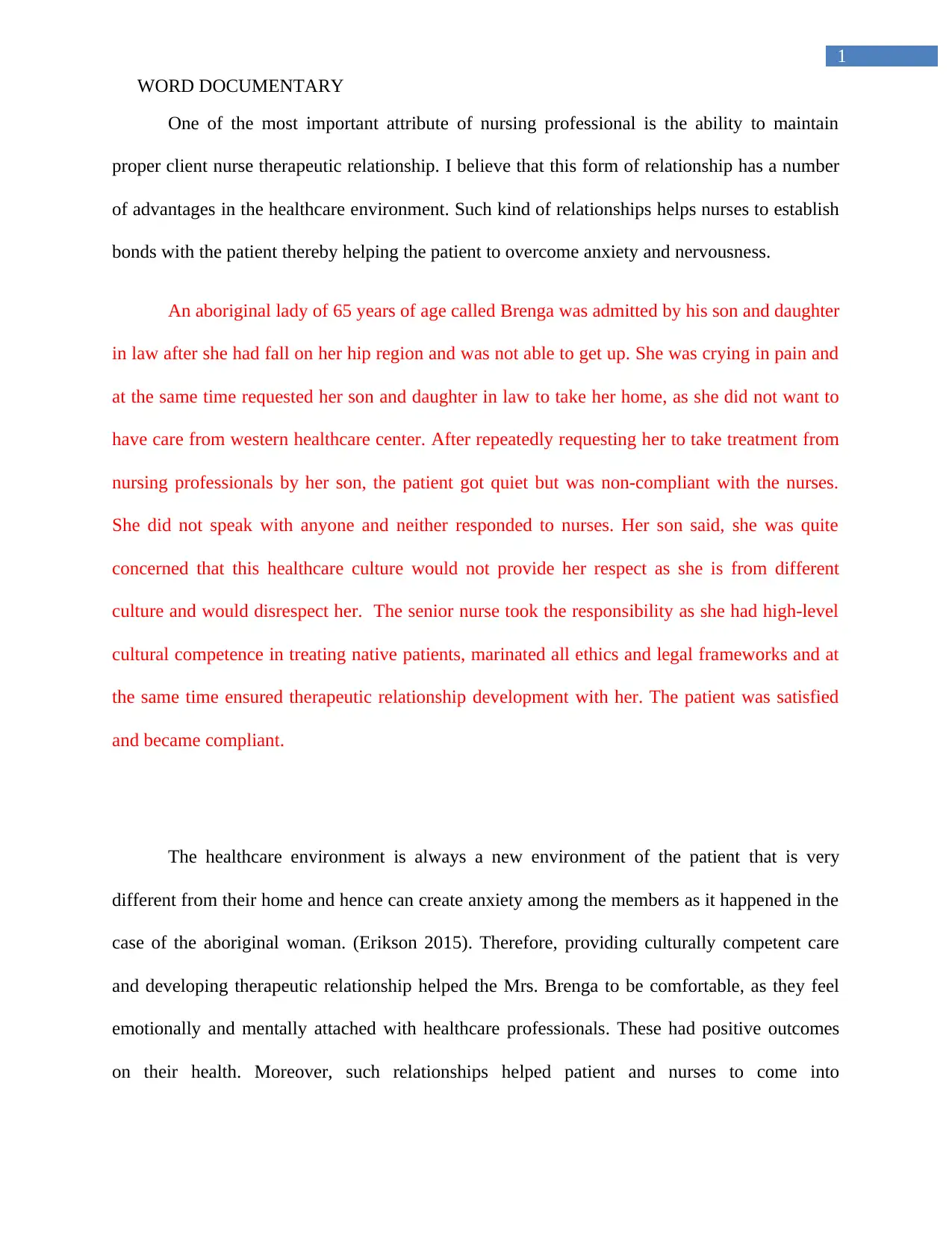
1
WORD DOCUMENTARY
One of the most important attribute of nursing professional is the ability to maintain
proper client nurse therapeutic relationship. I believe that this form of relationship has a number
of advantages in the healthcare environment. Such kind of relationships helps nurses to establish
bonds with the patient thereby helping the patient to overcome anxiety and nervousness.
An aboriginal lady of 65 years of age called Brenga was admitted by his son and daughter
in law after she had fall on her hip region and was not able to get up. She was crying in pain and
at the same time requested her son and daughter in law to take her home, as she did not want to
have care from western healthcare center. After repeatedly requesting her to take treatment from
nursing professionals by her son, the patient got quiet but was non-compliant with the nurses.
She did not speak with anyone and neither responded to nurses. Her son said, she was quite
concerned that this healthcare culture would not provide her respect as she is from different
culture and would disrespect her. The senior nurse took the responsibility as she had high-level
cultural competence in treating native patients, marinated all ethics and legal frameworks and at
the same time ensured therapeutic relationship development with her. The patient was satisfied
and became compliant.
The healthcare environment is always a new environment of the patient that is very
different from their home and hence can create anxiety among the members as it happened in the
case of the aboriginal woman. (Erikson 2015). Therefore, providing culturally competent care
and developing therapeutic relationship helped the Mrs. Brenga to be comfortable, as they feel
emotionally and mentally attached with healthcare professionals. These had positive outcomes
on their health. Moreover, such relationships helped patient and nurses to come into
WORD DOCUMENTARY
One of the most important attribute of nursing professional is the ability to maintain
proper client nurse therapeutic relationship. I believe that this form of relationship has a number
of advantages in the healthcare environment. Such kind of relationships helps nurses to establish
bonds with the patient thereby helping the patient to overcome anxiety and nervousness.
An aboriginal lady of 65 years of age called Brenga was admitted by his son and daughter
in law after she had fall on her hip region and was not able to get up. She was crying in pain and
at the same time requested her son and daughter in law to take her home, as she did not want to
have care from western healthcare center. After repeatedly requesting her to take treatment from
nursing professionals by her son, the patient got quiet but was non-compliant with the nurses.
She did not speak with anyone and neither responded to nurses. Her son said, she was quite
concerned that this healthcare culture would not provide her respect as she is from different
culture and would disrespect her. The senior nurse took the responsibility as she had high-level
cultural competence in treating native patients, marinated all ethics and legal frameworks and at
the same time ensured therapeutic relationship development with her. The patient was satisfied
and became compliant.
The healthcare environment is always a new environment of the patient that is very
different from their home and hence can create anxiety among the members as it happened in the
case of the aboriginal woman. (Erikson 2015). Therefore, providing culturally competent care
and developing therapeutic relationship helped the Mrs. Brenga to be comfortable, as they feel
emotionally and mentally attached with healthcare professionals. These had positive outcomes
on their health. Moreover, such relationships helped patient and nurses to come into
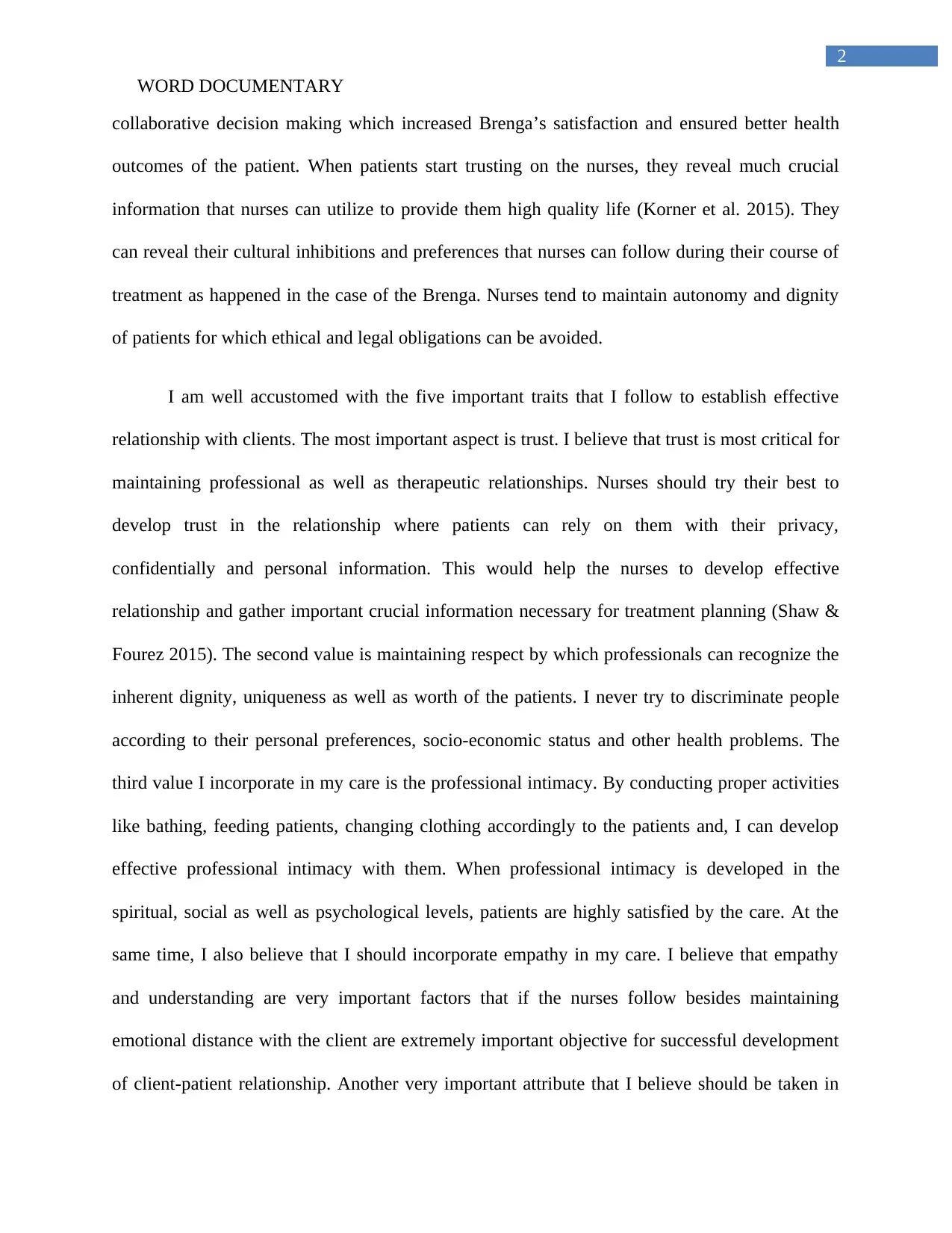
2
WORD DOCUMENTARY
collaborative decision making which increased Brenga’s satisfaction and ensured better health
outcomes of the patient. When patients start trusting on the nurses, they reveal much crucial
information that nurses can utilize to provide them high quality life (Korner et al. 2015). They
can reveal their cultural inhibitions and preferences that nurses can follow during their course of
treatment as happened in the case of the Brenga. Nurses tend to maintain autonomy and dignity
of patients for which ethical and legal obligations can be avoided.
I am well accustomed with the five important traits that I follow to establish effective
relationship with clients. The most important aspect is trust. I believe that trust is most critical for
maintaining professional as well as therapeutic relationships. Nurses should try their best to
develop trust in the relationship where patients can rely on them with their privacy,
confidentially and personal information. This would help the nurses to develop effective
relationship and gather important crucial information necessary for treatment planning (Shaw &
Fourez 2015). The second value is maintaining respect by which professionals can recognize the
inherent dignity, uniqueness as well as worth of the patients. I never try to discriminate people
according to their personal preferences, socio-economic status and other health problems. The
third value I incorporate in my care is the professional intimacy. By conducting proper activities
like bathing, feeding patients, changing clothing accordingly to the patients and, I can develop
effective professional intimacy with them. When professional intimacy is developed in the
spiritual, social as well as psychological levels, patients are highly satisfied by the care. At the
same time, I also believe that I should incorporate empathy in my care. I believe that empathy
and understanding are very important factors that if the nurses follow besides maintaining
emotional distance with the client are extremely important objective for successful development
of client-patient relationship. Another very important attribute that I believe should be taken in
WORD DOCUMENTARY
collaborative decision making which increased Brenga’s satisfaction and ensured better health
outcomes of the patient. When patients start trusting on the nurses, they reveal much crucial
information that nurses can utilize to provide them high quality life (Korner et al. 2015). They
can reveal their cultural inhibitions and preferences that nurses can follow during their course of
treatment as happened in the case of the Brenga. Nurses tend to maintain autonomy and dignity
of patients for which ethical and legal obligations can be avoided.
I am well accustomed with the five important traits that I follow to establish effective
relationship with clients. The most important aspect is trust. I believe that trust is most critical for
maintaining professional as well as therapeutic relationships. Nurses should try their best to
develop trust in the relationship where patients can rely on them with their privacy,
confidentially and personal information. This would help the nurses to develop effective
relationship and gather important crucial information necessary for treatment planning (Shaw &
Fourez 2015). The second value is maintaining respect by which professionals can recognize the
inherent dignity, uniqueness as well as worth of the patients. I never try to discriminate people
according to their personal preferences, socio-economic status and other health problems. The
third value I incorporate in my care is the professional intimacy. By conducting proper activities
like bathing, feeding patients, changing clothing accordingly to the patients and, I can develop
effective professional intimacy with them. When professional intimacy is developed in the
spiritual, social as well as psychological levels, patients are highly satisfied by the care. At the
same time, I also believe that I should incorporate empathy in my care. I believe that empathy
and understanding are very important factors that if the nurses follow besides maintaining
emotional distance with the client are extremely important objective for successful development
of client-patient relationship. Another very important attribute that I believe should be taken in
⊘ This is a preview!⊘
Do you want full access?
Subscribe today to unlock all pages.

Trusted by 1+ million students worldwide
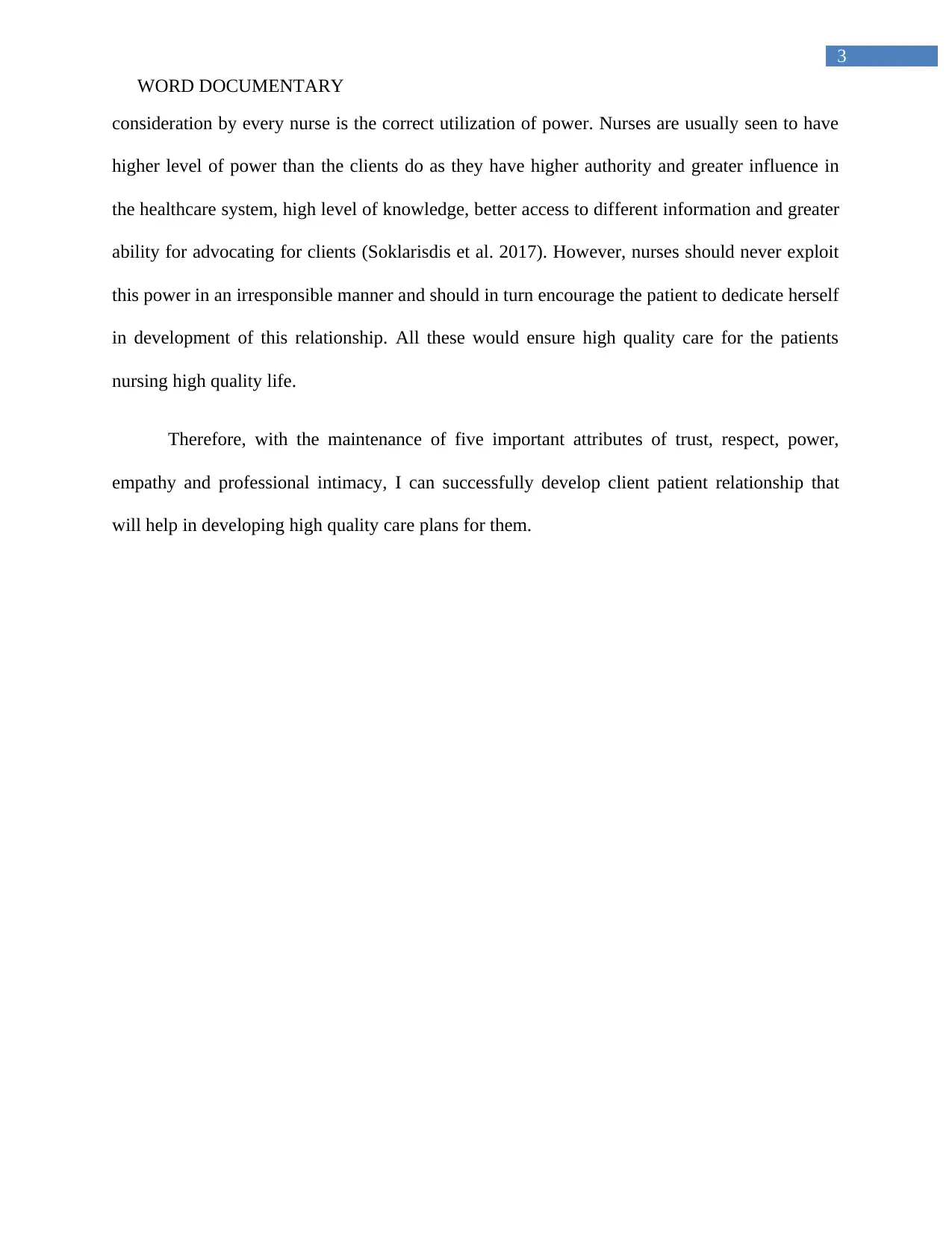
3
WORD DOCUMENTARY
consideration by every nurse is the correct utilization of power. Nurses are usually seen to have
higher level of power than the clients do as they have higher authority and greater influence in
the healthcare system, high level of knowledge, better access to different information and greater
ability for advocating for clients (Soklarisdis et al. 2017). However, nurses should never exploit
this power in an irresponsible manner and should in turn encourage the patient to dedicate herself
in development of this relationship. All these would ensure high quality care for the patients
nursing high quality life.
Therefore, with the maintenance of five important attributes of trust, respect, power,
empathy and professional intimacy, I can successfully develop client patient relationship that
will help in developing high quality care plans for them.
WORD DOCUMENTARY
consideration by every nurse is the correct utilization of power. Nurses are usually seen to have
higher level of power than the clients do as they have higher authority and greater influence in
the healthcare system, high level of knowledge, better access to different information and greater
ability for advocating for clients (Soklarisdis et al. 2017). However, nurses should never exploit
this power in an irresponsible manner and should in turn encourage the patient to dedicate herself
in development of this relationship. All these would ensure high quality care for the patients
nursing high quality life.
Therefore, with the maintenance of five important attributes of trust, respect, power,
empathy and professional intimacy, I can successfully develop client patient relationship that
will help in developing high quality care plans for them.
Paraphrase This Document
Need a fresh take? Get an instant paraphrase of this document with our AI Paraphraser
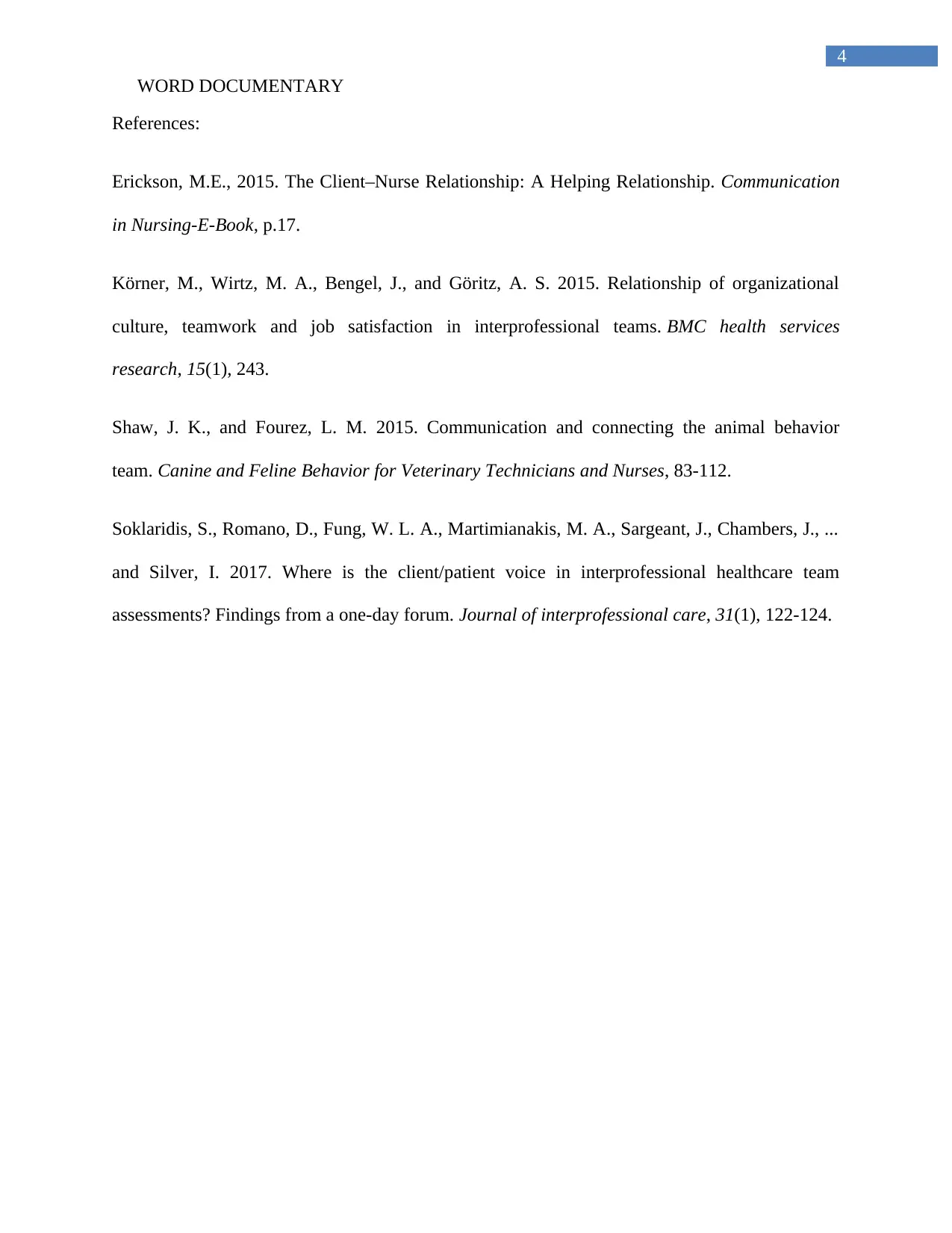
4
WORD DOCUMENTARY
References:
Erickson, M.E., 2015. The Client–Nurse Relationship: A Helping Relationship. Communication
in Nursing-E-Book, p.17.
Körner, M., Wirtz, M. A., Bengel, J., and Göritz, A. S. 2015. Relationship of organizational
culture, teamwork and job satisfaction in interprofessional teams. BMC health services
research, 15(1), 243.
Shaw, J. K., and Fourez, L. M. 2015. Communication and connecting the animal behavior
team. Canine and Feline Behavior for Veterinary Technicians and Nurses, 83-112.
Soklaridis, S., Romano, D., Fung, W. L. A., Martimianakis, M. A., Sargeant, J., Chambers, J., ...
and Silver, I. 2017. Where is the client/patient voice in interprofessional healthcare team
assessments? Findings from a one-day forum. Journal of interprofessional care, 31(1), 122-124.
WORD DOCUMENTARY
References:
Erickson, M.E., 2015. The Client–Nurse Relationship: A Helping Relationship. Communication
in Nursing-E-Book, p.17.
Körner, M., Wirtz, M. A., Bengel, J., and Göritz, A. S. 2015. Relationship of organizational
culture, teamwork and job satisfaction in interprofessional teams. BMC health services
research, 15(1), 243.
Shaw, J. K., and Fourez, L. M. 2015. Communication and connecting the animal behavior
team. Canine and Feline Behavior for Veterinary Technicians and Nurses, 83-112.
Soklaridis, S., Romano, D., Fung, W. L. A., Martimianakis, M. A., Sargeant, J., Chambers, J., ...
and Silver, I. 2017. Where is the client/patient voice in interprofessional healthcare team
assessments? Findings from a one-day forum. Journal of interprofessional care, 31(1), 122-124.
1 out of 5
Related Documents
Your All-in-One AI-Powered Toolkit for Academic Success.
+13062052269
info@desklib.com
Available 24*7 on WhatsApp / Email
![[object Object]](/_next/static/media/star-bottom.7253800d.svg)
Unlock your academic potential
Copyright © 2020–2025 A2Z Services. All Rights Reserved. Developed and managed by ZUCOL.





